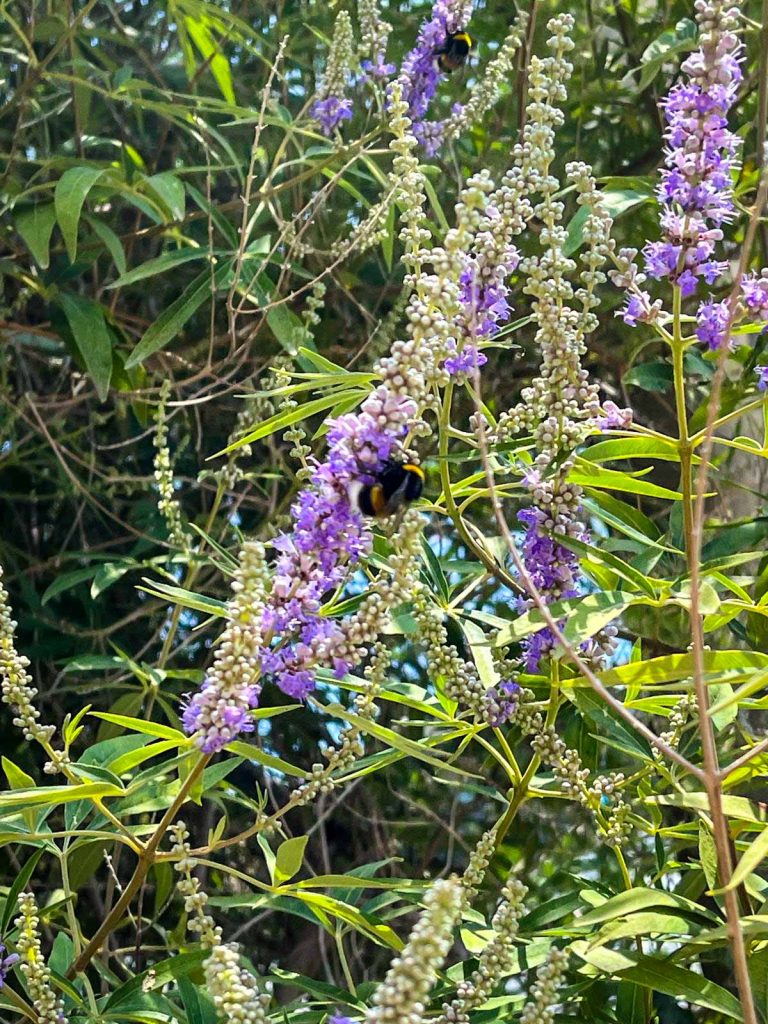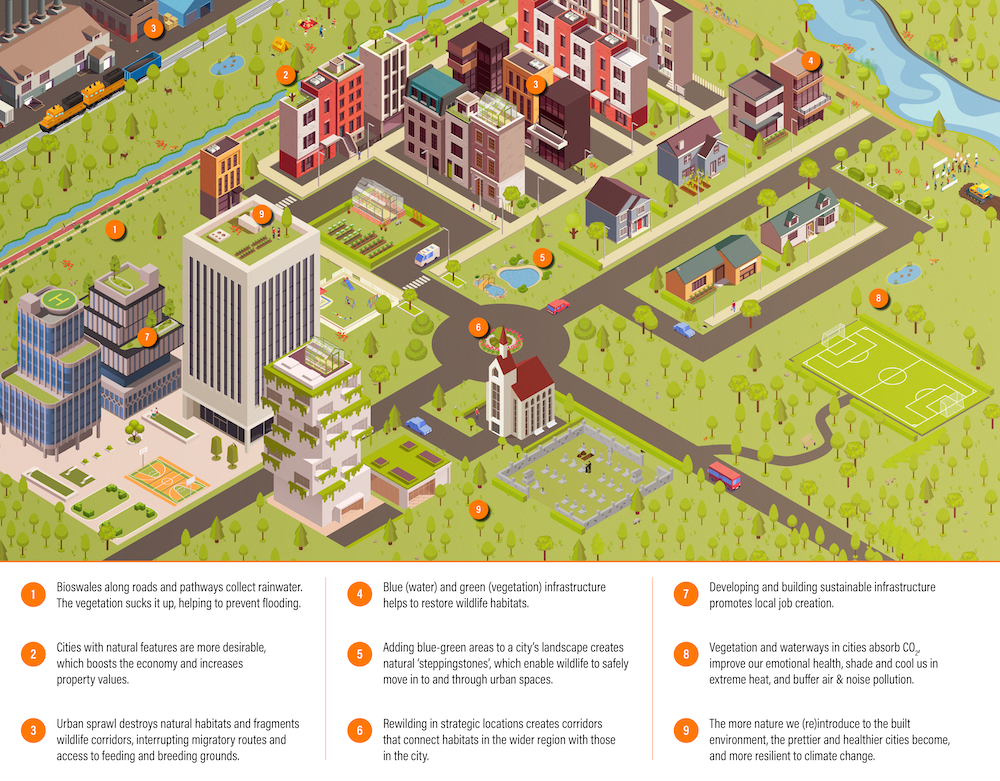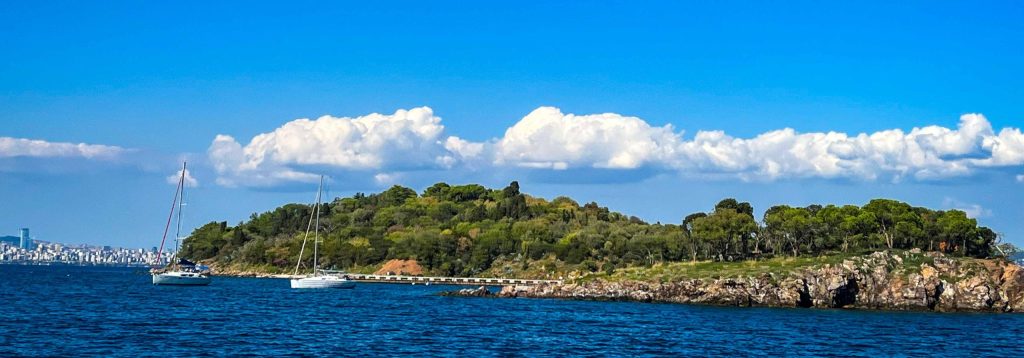Humans and wildlife have much in common. Urban sprawl deprives both of the resources, protection, and environmental stability that the natural world offers. Rewilding cities can reverse these fortunes. We explore what’s to gain from welcoming wildlife into urban spaces and how easily it can be achieved, with landscape architect Balin Koyunoglu.
In an urbanising world, cities expand and encroach on natural habitats. Reducing or removing vegetation to make way for the built environment has implications for biodiversity: it can damage the delicate balance of ecosystems and interrupt the food chain – which ripples all the way up to us.
Rewilding can reverse these misfortunes.
The term means much more than reintroducing species like wolves and beavers into the wilderness. Wildlife also has a place in the city – from tiny pollinators like bees to impressively giant trees. According to the European Commission, as much as 15% of urban space could be utilised for blue (water) and green (vegetation) infrastructure suitable for creating and connecting wildlife habitats.


What Does Rewilding Look Like?
Urban rewilding has a dual objective: establishing habitats and reintroducing wildlife.
Nature can only get a foothold if it has the right conditions to thrive.
Animals need safe spaces to live, move, feed, and reproduce, landscape architect Balin Koyunoglu explains. And so, in her designs, our CityChanger has to ensure the provision of:
- healthy soil for vegetation
- the right key species suited to the environment
- water sources
- corridors that connect habitats in which species can pass through and live in.
Soil and water often already exist in a city setting, but they may have become polluted, cut off, or buried. Rewilding requires us to clean and revive them.

Balin is something of a pioneer in this field. Urban rewilding is still a relatively new topic, especially in her native Turkey.
Before a career in landscaping, our CityChanger studied a master’s degree in ecological design and a PhD in urban conservation.
She has now worked for more than a decade on eco-sensitive projects for various corporate and public clients. Her time with Keikan Sekkei Tokyo was the most influential. This exposed Balin to the sensitivity that Japanese culture shows towards nature, where landscape design integrates the typography and opportunities for animals to roam.
If you’re practising landscape architecture, you have to know ecology, you have to know nature, you have to know human needs. It’s all interrelated.
These are principals Balin now applies with her Istanbul-based landscape design agency, Öteki Yer, where she aims to give “hundreds of endemic species” a space within urban environments in the Mediterranean region.
But, our CityChanger warns, because urban-dwelling humans have become disconnected from nature, we’re not all that motivated to protect it. “It’s hard to convince people.”
Rewilding at Scale
How we rally allies to rewild cities depends on the scale: micro or macro.
Changing Mindsets at a Local Level
Persuading stakeholders for smaller projects is fairly easy, our CityChanger admits. As long as we communicate clearly.
Show people what they can expect and help them reconnect with nature first-hand, Balin advises. Take them for a walk into the forest, for example. Then promise a design that mimics what they see, hear, and feel.
Rewilding is exactly that – wild. It won’t be manicured or maintained; some parts will be left fallow so that species can claim it. “It will not look like Versailles, or the parks that everyone admires. It’s not a comfort zone where people go to drink coffee or sunbathe. So, you have to change the mindset; you need local people to adapt.”
But it can be a bit of both. One of Balin’s designs for a garden within a residential development in Koyunbaba, Gumusluk, Bodrum combined wild land rehabilitation with vegetable gardens and benches to sit and eat at.
The whole site – water and soil included – was cleaned. Existing plants were restored, and new species introduced to enhance biodiversity. This created a green corridor, connecting the new garden with a large natural olive tree forest so that species like hedgehogs and wild boar could come and go. It was a big hit!

That’s not the end, though. “If you just insert something and then leave the site, it won’t work.” Someone has to look out for nature after the landscape designer and construction teams have left.
So, Balin also works to instil a sense of stewardship in local communities – by making it fun.
Together with schoolchildren and their parents for a project on the island of Imbros (or Gökçeada), northern Turkey, she led activities like ‘geocaching’ – a type of scavenger hunt – to get them out into nature. They planted flowers and attracted wildlife into their gardens by putting “gifts out for the animals to eat”.
Just educate them. Show them nature and its processes. They love it, because they connect with it instinctively.
Macro Scale – Standards Are a Persuasive Mechanism
Habitat and biodiversity preservation is part of the UN’s Sustainable Development Goals. The EU has similar commitments in its 2030 biodiversity strategy. Many cities have their own climate goals to hit over the next 30 years. Rewilding is one simple way to achieve them all.
Still, municipalities are tough cookies to crack. They often seek tangible benefits before agreeing to big budget infrastructure projects.
Balin advises we avoid using the word ‘rewilding’ when speaking to decision-makers: “They think of weird animals walking on the streets. You need to tell them in a different way.”
Focus on the socio-economic impacts, she says – the cost savings and health benefits:
Blue-green building blocks of ecosystems – like lakes and parks – double up as public amenities where people can walk, run, and cycle for the good of their health.
Developing and building sustainable infrastructure promotes job creation and adds value to local properties.
Creating spaces for nature in urban areas makes cities more resilient to climate change. Habitats are widely known to:
- absorb CO2
- improve emotional health
- shade and cool us in extreme heat
- buffer the threat of air and noise pollution
- aid in stormwater management and prevent the floods which cause expensive interruptions to city functions.
If you’re not doing it for nature or for the city, do it for yourself, for your children.

Rewilding in the Urban Design Guidelines
This is how Balin approached the case of Princes’ Island, located off Istanbul’s shoreline in the Marmara Sea, where she identified potential for green corridors and patches of land suitable for rewilding.
Although the forest is protected, our CityChanger recorded high levels of noise and saw a lot of light used around the forest and on the paths though it at night. There was little sign of nesting animals because of this disturbing human activity. “It’s not a small issue,” Balin says.
In Turkey – as elsewhere – legislation to tackle this is scant. Getting it implemented is a slow process – and a dead end when the legislation clashes with other political priorities.
In lieu of enforceable policy, Balin teamed up with Bimtaş, an engineering arm of Istanbul Metropolitan Municipality, to publish a series of design guides.
These pull together the design standards that professionals can apply to their landscaping projects, which acts to mainstream rewilding concepts. The beauty is, when you know about them, it’s simple to do – seemingly evidenced by the fact that the city’s ministries are in the process of officially approving them.
“It’s not so hard. Follow the standards, and you get the benefits.”

In Turkey, these standards exist for noise but those for lighting we’re so much enforced. “I found the regulations from the dusty files,” she jokes. By including these in the design guides, alongside her own recommendations for ecological best practices, it was possible to “force people to use these regulations in the islands”.
Based on her extensive international, multi-scale experience, the aim of this is to create a culture among the landscape-designer community that prioritises habitat conservation much like Balin witnessed in Japan.
It’s faster than legislation. We can start with that because we need immediate action.
What Can You Do? – Advice for First-time Rewilders
The more ‘green and blue’ we reintroduce to urban spaces, the prettier, healthier, and more resilient our cities will be.
“Every green area needs to be rewilded,” Balin stresses: gardens, parks, streets, allotments, sports fields, roundabouts, bioswales, urban farms, cemeteries, etc.
But we can’t leave it all to landscape designers. Everyone should get involved with rewilding somehow, Balin says – or rather not get involved!
First, we need a habitat: “Build balcony gardens with a key species, native ones. If you have a roof, add a planter. It’s really easy. Just plant them. Birds will come. Bees will come. If you start with that, it will grow.”
Then, simply leave it alone to ‘evolve’ naturally. “Don’t use pesticides.”
No Mow May is a great example of positive inaction. Balin is a real fan. It’s a campaign that asks us to not cut the grass, trim bushes, or prune flowers throughout May (preferably also April and June).
In the northern hemisphere, this is when meadows, lawns, parks, rooftops, and window boxes left ‘wild’ will swarm with insects – pollinators that we need and a veritable restaurant for the thousands of migratory birds that arrive in Istanbul at this time of year.
“Just don’t do anything! It’s so simple,” Balin states with joy. “Keep it simple, and people will do it.”
What simpler way is there to improve the quality of life in our cities than doing nothing?


